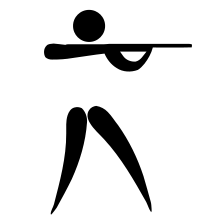Shooting_at_the_1976_Summer_Olympics_–_Mixed_50_metre_pistol
Shooting at the 1976 Summer Olympics – Mixed 50 metre pistol
Olympic shooting event
The mixed (or "open") ISSF 50 meter pistol was a shooting sports event held as part of the Shooting at the 1976 Summer Olympics programme. It was the fourteenth appearance of the event. The competition was held on 18 July 1976 at the shooting ranges in Montreal. 47 shooters from 31 nations competed.[1] Nations had been limited to two shooters each since the 1952 Games. The event was won by Uwe Potteck, with East Germany finishing 1–2 as Harald Vollmar took silver. It was East Germany's first victory in the event. Rudolf Dollinger of Austria repeated as bronze medalist. Vollmar (the 1968 bronze winner) and Dollinger were the fifth and sixth men to win multiple medals in the free pistol. Potteck had only begun the sport 23 months prior to his victory and his previous personal best in domestic competitions was a 568. In addition, his practice scores leading up to the games averaged around 563 to 565.[2][3]
